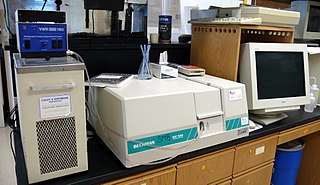Related Research Articles

Cytochromes are redox-active proteins containing a heme, with a central iron (Fe) atom at its core, as a cofactor. They are involved in the electron transport chain and redox catalysis. They are classified according to the type of heme and its mode of binding. Four varieties are recognized by the International Union of Biochemistry and Molecular Biology (IUBMB), cytochromes a, cytochromes b, cytochromes c and cytochrome d.

The visible spectrum is the band of the electromagnetic spectrum that is visible to the human eye. Electromagnetic radiation in this range of wavelengths is called visible light. The optical spectrum is sometimes considered to be the same as the visible spectrum, but some authors define the term more broadly, to include the ultraviolet and infrared parts of the electromagnetic spectrum as well.

Ultraviolet (UV) spectroscopy or ultraviolet–visible (UV-VIS) spectrophotometry refers to absorption spectroscopy or reflectance spectroscopy in part of the ultraviolet and the full, adjacent visible regions of the electromagnetic spectrum. Being relatively inexpensive and easily implemented, this methodology is widely used in diverse applied and fundamental applications. The only requirement is that the sample absorb in the UV-Vis region, i.e. be a chromophore. Absorption spectroscopy is complementary to fluorescence spectroscopy. Parameters of interest, besides the wavelength of measurement, are absorbance (A) or transmittance (%T) or reflectance (%R), and its change with time.
Circular dichroism (CD) is dichroism involving circularly polarized light, i.e., the differential absorption of left- and right-handed light. Left-hand circular (LHC) and right-hand circular (RHC) polarized light represent two possible spin angular momentum states for a photon, and so circular dichroism is also referred to as dichroism for spin angular momentum. This phenomenon was discovered by Jean-Baptiste Biot, Augustin Fresnel, and Aimé Cotton in the first half of the 19th century. Circular dichroism and circular birefringence are manifestations of optical activity. It is exhibited in the absorption bands of optically active chiral molecules. CD spectroscopy has a wide range of applications in many different fields. Most notably, UV CD is used to investigate the secondary structure of proteins. UV/Vis CD is used to investigate charge-transfer transitions. Near-infrared CD is used to investigate geometric and electronic structure by probing metal d→d transitions. Vibrational circular dichroism, which uses light from the infrared energy region, is used for structural studies of small organic molecules, and most recently proteins and DNA.

Astronomical spectroscopy is the study of astronomy using the techniques of spectroscopy to measure the spectrum of electromagnetic radiation, including visible light, ultraviolet, X-ray, infrared and radio waves that radiate from stars and other celestial objects. A stellar spectrum can reveal many properties of stars, such as their chemical composition, temperature, density, mass, distance and luminosity. Spectroscopy can show the velocity of motion towards or away from the observer by measuring the Doppler shift. Spectroscopy is also used to study the physical properties of many other types of celestial objects such as planets, nebulae, galaxies, and active galactic nuclei.
The color of chemicals is a physical property of chemicals that in most cases comes from the excitation of electrons due to an absorption of energy performed by the chemical. What is seen by the eye is not the color absorbed, but the complementary color from the removal of the absorbed wavelengths. This spectral perspective was first noted in atomic spectroscopy.

Absorption spectroscopy is spectroscopy that involves techniques that measure the absorption of electromagnetic radiation, as a function of frequency or wavelength, due to its interaction with a sample. The sample absorbs energy, i.e., photons, from the radiating field. The intensity of the absorption varies as a function of frequency, and this variation is the absorption spectrum. Absorption spectroscopy is performed across the electromagnetic spectrum.

Spectrophotometry is a branch of electromagnetic spectroscopy concerned with the quantitative measurement of the reflection or transmission properties of a material as a function of wavelength. Spectrophotometry uses photometers, known as spectrophotometers, that can measure the intensity of a light beam at different wavelengths. Although spectrophotometry is most commonly applied to ultraviolet, visible, and infrared radiation, modern spectrophotometers can interrogate wide swaths of the electromagnetic spectrum, including x-ray, ultraviolet, visible, infrared, and/or microwave wavelengths.

Fluorescence spectroscopy is a type of electromagnetic spectroscopy that analyzes fluorescence from a sample. It involves using a beam of light, usually ultraviolet light, that excites the electrons in molecules of certain compounds and causes them to emit light; typically, but not necessarily, visible light. A complementary technique is absorption spectroscopy. In the special case of single molecule fluorescence spectroscopy, intensity fluctuations from the emitted light are measured from either single fluorophores, or pairs of fluorophores.

Cytochromes P450 are a superfamily of enzymes containing heme as a cofactor that mostly, but not exclusively, function as monooxygenases. In mammals, these proteins oxidize steroids, fatty acids, and xenobiotics, and are important for the clearance of various compounds, as well as for hormone synthesis and breakdown. In 1963, Estabrook, Cooper, and Rosenthal described the role of CYP as a catalyst in steroid hormone synthesis and drug metabolism. In plants, these proteins are important for the biosynthesis of defensive compounds, fatty acids, and hormones.

Jacques-Louis Soret was a Swiss chemist and spectroscopist. He studied both spectroscopy and electrolysis.
In spectroscopy, hypsochromic shift is a change of spectral band position in the absorption, reflectance, transmittance, or emission spectrum of a molecule to a shorter wavelength. Because the blue color in the visible spectrum has a shorter wavelength than most other colors, this effect is also commonly called a blue shift. It should not be confused with a bathochromic shift, which is the opposite process – the molecule's spectra are changed to a longer wavelength.

A chromophore is a molecule which absorbs light at a particular wavelength and emits color as a result. Chromophores are commonly referred to as colored molecules for this reason. The word is derived from "chromo-," which means color, and "-phore," which means "carrier of." Many molecules in nature are chromophores, including chlorophyll, the molecule responsible for the green colors of leaves. The color that is seen by our eyes is that of the light not absorbed by the reflecting object within a certain wavelength spectrum of visible light. The chromophore indicates a region in the molecule where the energy difference between two separate molecular orbitals falls within the range of the visible spectrum. Visible light that hits the chromophore can thus be absorbed by exciting an electron from its ground state into an excited state. In biological molecules that serve to capture or detect light energy, the chromophore is the moiety that causes a conformational change in the molecule when hit by light.
In theoretical chemistry, molecular electronic transitions take place when electrons in a molecule are excited from one energy level to a higher energy level. The energy change associated with this transition provides information on the structure of the molecule and determines many of its properties, such as colour. The relationship between the energy involved in the electronic transition and the frequency of radiation is given by Planck's relation.
Woodward's rules, named after Robert Burns Woodward and also known as Woodward–Fieser rules are several sets of empirically derived rules which attempt to predict the wavelength of the absorption maximum (λmax) in an ultraviolet–visible spectrum of a given compound. Inputs used in the calculation are the type of chromophores present, the auxochromes (substituents on the chromophores, and solvent. Examples are conjugated carbonyl compounds, conjugated dienes, and polyenes.

The visible and near-infrared (VNIR) portion of the electromagnetic spectrum has wavelengths between approximately 400 and 1100 nanometers (nm). It combines the full visible spectrum with an adjacent portion of the infrared spectrum up to the water absorption band between 1400 and 1500 nm. Some definitions also include the short-wavelength infrared band from 1400 nm up to the water absorption band at 2500 nm. VNIR multi-spectral image cameras have wide applications in remote sensing and imaging spectroscopy. Hyperspectral Imaging Satellite carried two payloads, among which one was working on the spectral range of VNIR.

The absorption of electromagnetic radiation by water depends on the state of the water.

eFluor nanocrystals are a class of fluorophores made of semiconductor quantum dots. The nanocrystals can be provided as either primary amine, carboxylate, or non-functional groups on the surface, allowing conjugation to biomolecules of a researcher's choice. The nanocrystals can be conjugated to primary antibodies which are used for flow cytometry, immunohistochemistry, microarrays, in vivo imaging and microscopy.

Porphyrazines, or tetraazaporphyrins, are tetrapyrrole macrocycles similar to porphyrins and phthalocyanines. Pioneered by Sir R. Patrick Linstead as an extension of his work on phthalocyanines, porphyrazines differ from porphyrins in that they contain -meso nitrogen atoms, rather than carbon atoms, and differ from phthalocyanines in that their β-pyrrole positions are open for substitution. These differences confer physical properties that are distinct from both porphyrins and phthalocyanines.
Martin Paul Gouterman was an American chemist who was a professor of chemistry at the University of Washington. He is remembered for his seminal work on the optical spectra porphyrins, for which he developed a simple model generally referred to as Gouterman's four-orbital model.
References
- ↑ Jacques-Louis Soret (1883). "Analyse spectrale: Sur le spectre d'absorption du sang dans la partie violette et ultra-violette". Comptes rendus de l'Académie des sciences (in French). 97: 1269–1270.
- ↑ E. Heftmann (26 November 1991). Journal of Chromatography Library. Elsevier. pp. 2–. ISBN 978-0-08-085859-3 . Retrieved 6 May 2013.
- ↑ David F. Lewis (1996). Cytochromes P450: Structure, Function and Mechanism. Taylor & Francis. pp. 1–. ISBN 978-0-7484-0443-8 . Retrieved 6 May 2013.